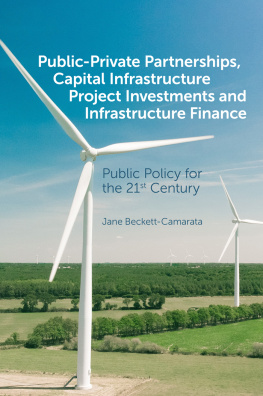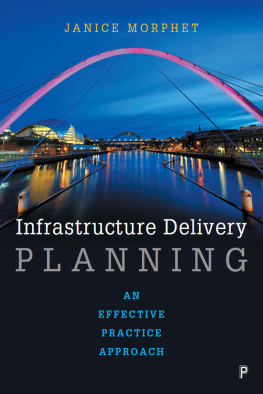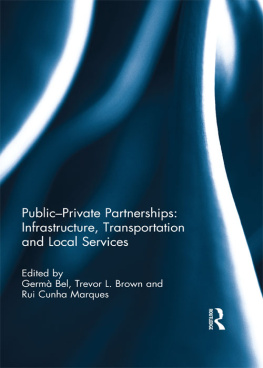Public-Private Partnerships, Capital Infrastructure Project Investments and Infrastructure Finance: Public Policy for the 21st Century
JANE BECKETT-CAMARATA
Pennsylvania State University-Harrisburg, USA
United Kingdom North America Japan India Malaysia China
Emerald Publishing Limited
Howard House, Wagon Lane, Bingley BD16 1WA, UK
First edition 2020
Copyright 2020 Jane Beckett-Camarata
Published under exclusive licence by Emerald Publishing Limited.
Reprints and permissions service
Contact:
No part of this book may be reproduced, stored in a retrieval system, transmitted in any form or by any means electronic, mechanical, photocopying, recording or otherwise without either the prior written permission of the publisher or a licence permitting restricted copying issued in the UK by The Copyright Licensing Agency and in the USA by The Copyright Clearance Center. Any opinions expressed in the chapters are those of the authors. Whilst Emerald makes every effort to ensure the quality and accuracy of its content, Emerald makes no representation implied or otherwise, as to the chapters' suitability and application and disclaims any warranties, express or implied, to their use.
British Library Cataloguing in Publication Data
A catalogue record for this book is available from the British Library
ISBN: 978-1-83909-655-6 (Print)
ISBN: 978-1-83909-654-9 (Online)
ISBN: 978-1-83909-656-3 (Epub)
Table of Contents
About the Author
Dr Beckett-Camarata teaches in the Penn State Harrisburg PhD and Master's program in public administration. Her finance teaching interests include publicprivate partnerships, government revenue systems, public financial management, budgeting, capital budgeting, infrastructure finance, cost accounting, and governmental accounting and managerial accounting. Dr Beckett-Camarata was a recipient of a Lilly Foundation Scholar Award for the advancement of teaching excellence. She has taught university courses in Russia and was a Fulbright Scholar at Kharhiv National University in Kharkiv, Ukraine, where she taught economic development finance. While at the University of North Wales, Bangor, Wales, she researched the impact of the European Union on bank regulation.
Dr Beckett-Camarata has authored many articles and book chapters. Her work has been published in the Public Productivity and Management Review, Journal of Budgeting, Accounting and Financial Management, Municipal Finance Journal, International Journal of Public Administration, American Review of Public Administration, Journal of Business Research, Handbook of Public Sector Economics and Handbook of Globalization, and Governance and Public Administration. She was the recipient of the Baruch College, CUNY distinguished Municipal Leadership and Finance Award, which funded her 2005 summer research on changes in New York City's pension fund infrastructure during fiscal crisis.
As a former chief financial officer in the Commonwealth of Virginia, Dr Beckett-Camarata managed operating and capital budgets, financial accounting and reporting, and revenue forecasting and publicprivate partnerships. She was instrumental in integrating the strategic plan into the budget and accounting system and establishing and integrating financial performance measures.
She serves as an expert reviewer for the Government Finance Officers Association and as an expert witness for the US Federal Court System in government budgeting. She also serves on the editorial board of several academic journals.
Dr Beckett-Camarata is active in professional organizations including the American Society for Public Administration, where she has served as cochair of the Finance Committee, Executive Council, and Audit Committee; Association for Budgeting and Financial Management, where she has served on the Board of Directors, the Program Committee, and the Curro Award Committee; National Association of Schools of Public Affairs and Administration, where she has served on site visit teams and on the Commission on Peer Review and Accreditation; the Government Finance Officers Association; and numerous other organizations.
Dr Beckett-Camarata received a PhD in public policy and administration from Virginia Commonwealth University (1998); Master of Public Administration from the American University (1989); and Bachelor of Science degree with a concentration in Finance from Syracuse University (1983).
Introduction
This book examines the use of PublicPrivate Partnerships (PPPs) in the context of capital infrastructure investment and infrastructure finance policy implementation. The decision to use PPPs should be framed and considered within the context of infrastructure finance policy, especially for Emerging Market Economies. In this regard, the use of PPPs can be seen more broadly as an efficient and effective public policy tool.
Governments worldwide are becoming increasingly more dependent on infrastructure finance policy to implement capital improvements planning. They typically identify one or more financing options in their infrastructure finance policy, including the use of PPPs and concomitant capital infrastructure investment. PPPs are a form of institutional arrangement between the public and private sectors (Hodge & Greve, 2016) for increased private sector involvement in the delivery of capital infrastructure. PPPs may be among the best option for delivering a completed capital infrastructure, especially with complex capital infrastructure involving more than basic construction and financing (Gross, 2018). Long-term Infrastructure Finance Policy should be the basis for capital infrastructure investment, capital improvements planning and financing and acquisition (Beckett-Camarata, 2019), and to achieve capital infrastructure finance policy goals. To date, there has been insufficient recognition of the importance of Infrastructure Finance Policy and capital improvement planning in identifying potential uses of PPPs (Beckett-Camarata, 2019). This lack of recognition is because the Infrastructure Finance Policy implementation phase includes a number of complex steps including comprehensive and strategic planning, capital needs assessment, project cost estimation, project priority ranking, and capital improvements planning (Bunch, 2013; Marlowe, Rivenbark, & Vogt, 2009; Millar, 1988; Srithongrung, 2018; Steiss, 2005; Vogt, 2004). Although much is written on various aspects of PPPs, this book is important because it integrates Infrastructure Finance Policy, the selection of PPPs to finance and deliver an infrastructure capital project as a policy option, and a unified and comprehensive Capital Management and Budgeting system to manage the PPP from a public policy planning and implementation perspective.
Thus, this book introduces a new lens to look at Infrastructure Finance Policy as a policy instrument with which to achieve long-term national and subnational finance policy objectives. It incorporates the identification, selection, implementation, and evaluation of PPPs within the framework of strategic infrastructure finance policy objectives and the capital improvements planning process. The book is unique in that it introduces the need to implement and evaluate the adoption of PPPs within the context of long-term capital investment and capital improvements planning and as a critical aspect of effective long-term infrastructure finance policy. With the incorporation of new market-oriented approaches to infrastructure finance policy decision-making in the public sector, there is a greater emphasis on economy and efficiency in order to deliver public services at the lowest cost (Osborne, 2002). However, additionally, there is a critical need to implement and evaluate the effectiveness of Infrastructure Finance Policy implementation. Governments may choose to finance some or all capital infrastructure investment and also use private sector expertise and efficiency (The World Bank, 2018a, 2018b) through PPPs to finance and deliver capital infrastructure.











